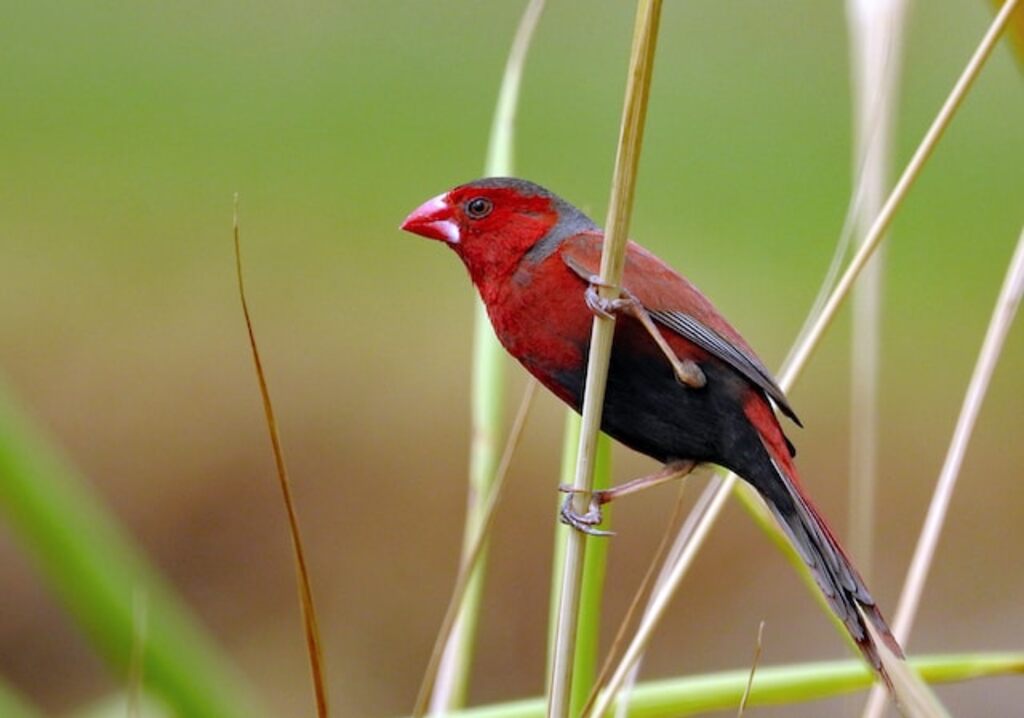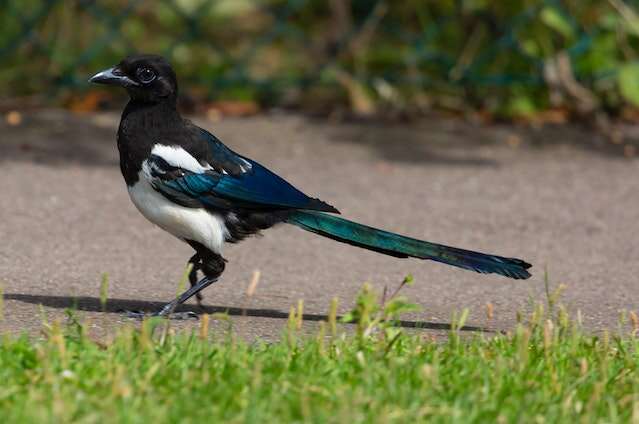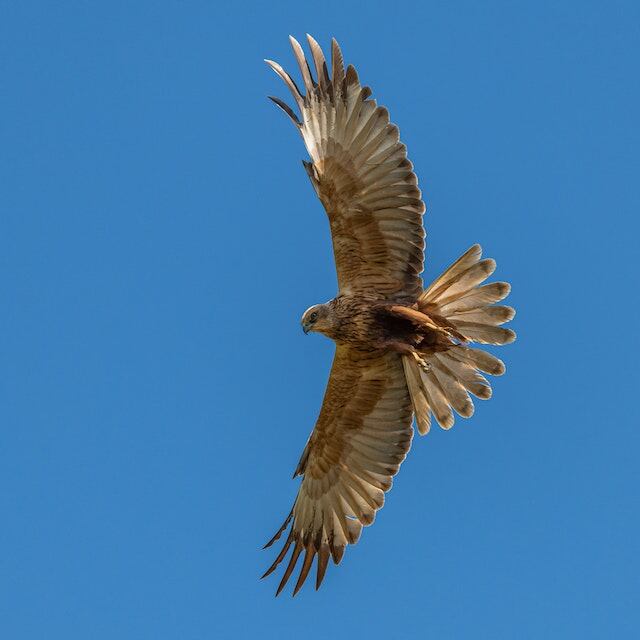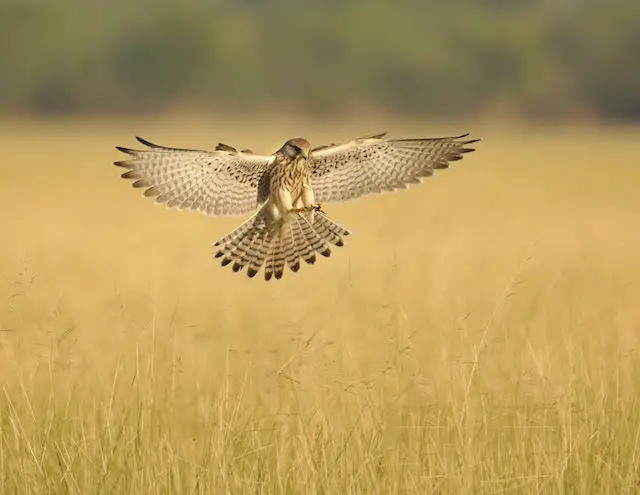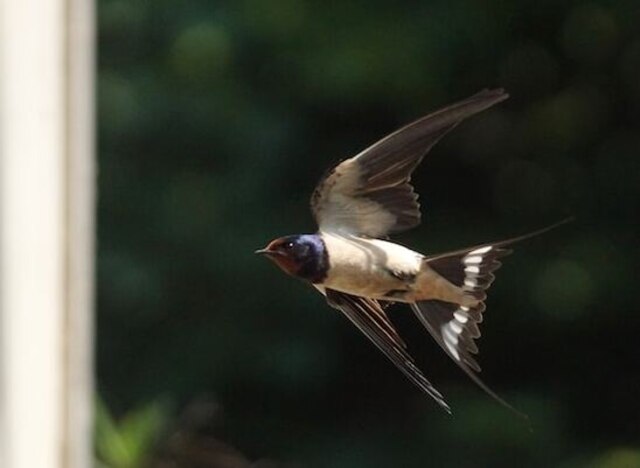The bird tail is one of the most distinctive and important features of avian anatomy. While we may not give it much thought, the tail feathers, or rectrices, serve crucial functions in flight, balance, and even mating.
In this comprehensive look at the bird tail, we will explore the many ways in which this fascinating appendage shapes the lives of birds and contributes to their remarkable diversity and success.
Table of Contents
- 1 What is the Bird Tail?
- 2 Anatomy of the Bird Tail: Defining the Bones and Muscles
- 3 The Evolution of Bird Tails
- 4 Structural Variety: Exploring Different Types of Tails
- 5 The Benefits of Having a Tail: How Bird Anatomy Helps in Flight
- 6 Tail Feathers: Different Types of Feathers and Their Functions
- 7 Tail Color: How Tail Feathers Influence Bird Coloration
- 8 Tail Movement: How Birds Use Their Tails for Maneuvering
- 9 Tail Posture: How Birds Use Their Tails for Visual Communication
- 10 Tail Displays: How Birds Use Tail Feathers to Attract Mates
- 11 Tail Feather Molting: How Birds Replace Their Tail Feathers
- 12 Tail Feather Abnormalities: Causes and Effects of Abnormal Tail Feathers
- 13 FAQs About The Bird Tail
- 13.1 What is the purpose of bird tails?
- 13.2 How do bird tails differ between species?
- 13.3 What causes the vibrant colors in bird tails?
- 13.4 Do all bird species have tails?
- 13.5 Do male and female birds have different tail feathers?
- 13.6 How often do birds molt their tail feathers?
- 13.7 Can birds fly without their tails?
- 14 Conclusion: The Role of the Tail in Bird Biology
- 15 Author
What is the Bird Tail?
The bird tail is a fundamental part of a bird’s anatomy, consisting of feathers and bones that provide balance, maneuverability, and stability during flight. It plays a crucial role in enabling birds to take off, fly, and land, as well as in communication, courtship, and defense.
The complexity and variation of bird tail structures are vast, with different shapes, sizes, and functions among different bird species. Ultimately, the bird tail is an essential feature that has enabled birds to conquer the skies and adapt to diverse environments across the world.
Anatomy of the Bird Tail: Defining the Bones and Muscles
The bird tail is a remarkable feat of evolution, designed to enable birds to fly with precision and efficiency. Comprising several bones, muscles, and feathers, the tail plays a crucial role in the bird’s overall aerodynamics.
At the base of each tail feather, there are small muscles that help the bird generate thrust and lift, thus assisting with flight. Most bird species have twelve rectrices, or tail feathers, in their tails, though the total number of rectrices can range from six to thirty-two.
In addition to providing lift and stability in flight, the tail feathers also play a role in communication and mating displays. Many bird species use their tail feathers to attract mates, with males often displaying their tails in elaborate courtship dances.
To better understand the complexity of the bird tail, here is a table outlining the different types of tail shapes and their functions in various bird species:
| Tail Shape | Function | Examples |
|---|---|---|
| Forked | Increases maneuverability and speed | Swallows, terns |
| Rounded | Provides stability in flight | Doves, pigeons |
| Fan-shaped | Enhances steering and control | Hawks, eagles |
| Graduated | Aids in braking and slowing down | Ducks, geese |
Overall, the bird tail is a fascinating aspect of avian anatomy, with its diverse shapes and functions contributing to the unique capabilities of different bird species.
The Evolution of Bird Tails
The evolution of bird tails has been an interesting topic for scientists for many years. It’s amazing to think about how the tail of a bird has changed and adapted over time. While the basic anatomy of the bird tail has remained the same, the shape, size, and structure of the tail has changed drastically through the course of evolution.
Driven by Need to Fly More Efficiently
The evolution of bird tails has been driven by the need to fly more efficiently and survive in different environments. The earliest birds had short, stiff tails that were used primarily for balance while climbing and perching.
Longer and More Flexible Tails for Greater Control
As birds evolved and began to fly more, their tails became longer and more flexible, allowing for greater control and maneuverability in the air. During the Late Cretaceous period, birds developed highly specialized tails adapted for specific environments.
Specialized Tails for Hunting and Survival
These specialized tails allowed birds to hunt and survive in different ways. Today, modern birds have a diverse range of tail shapes and sizes, reflecting adaptations to different lifestyles and environments.
Diverse Range of Tail Shapes and Sizes
For example, many species of birds have evolved longer and more curved tails to help them maneuver better in the air. This helps them when they are flying and makes them more agile in the air. Other species of birds have evolved shorter and more pointed tails to help them when they are diving and swooping. This helps them to dive faster and more accurately.
Importance of the Tail
The tail is an important part of the bird’s anatomy, as it helps them to stay balanced in the air and gives them greater control when they are flying. Through the process of evolution, birds have adapted their tails to help them move in different ways. This has helped them to become more efficient flyers and has enabled them to survive in a wide variety of environments.
Sure, here is a table summarizing the evolution of bird tails over time:
| Evolutionary Period | Tail Characteristics |
|---|---|
| Early birds (150 million years ago) | Short, stiff tails used for balance during climbing and perching |
| Mid-Cretaceous (110-100 million years ago) | Longer, more flexible tails used for steering and aerial maneuverability |
| Late Cretaceous (100-66 million years ago) | Highly specialized tails adapted for different environments, such as short pointed tails for diving and long curved tails for agility in flight |
| Modern birds (66 million years ago to present) | Diverse range of tail shapes and sizes, reflecting adaptations to different lifestyles and environments |
Structural Variety: Exploring Different Types of Tails
The bird tail is one of the most diverse and intriguing body parts of a bird. Not only can it come in a variety of shapes and sizes, but different birds of the same species often have distinctively different tails.
There are three primary types of tails found in birds:
- The fan tail, the forked tail, and the rounded tail. The fan tail is characterized by a wide, rounded shape with feathers that are spread out in a fan-like pattern. These tails are often seen in birds such as peacocks and pheasants.
- The forked tail is most commonly seen in birds such as swallows and swifts. These tails have two distinct points and are longer than the fan tail.
- The rounded tail is seen in small birds such as wrens and finches. These tails are short, round, and stubby in comparison to the other two types.
Each of these different tails has a purpose and provides a unique advantage to the bird. By understanding the structure of the various types of bird tails, we can gain a better appreciation for how amazing and diverse the avian world truly is.
here’s a table outlining the different types of bird tails:
| Tail Type | Description | Examples |
|---|---|---|
| Fan Tail | Wide, rounded shape with feathers spread out in a fan-like pattern | Peacocks, pheasants |
| Forked Tail | Two distinct points and longer than the fan tail | Swallows, swifts |
| Rounded Tail | Short, round, and stubby compared to the other two types | Wrens, finches |
Each of these tail types serves a specific purpose and provides unique advantages to the bird. Understanding the structural variety of bird tails can help us appreciate the amazing diversity of the avian world.
The Benefits of Having a Tail: How Bird Anatomy Helps in Flight
Birds are unique creatures that possess some of the most advanced and specialized body parts found in nature. One of the most important features of a bird’s anatomy is its tail, which plays a vital role in helping birds fly.
Stabilization and Direction in Flight
The tail helps to stabilize and direct a bird’s flight path, and it also provides additional lift when necessary. In this section, we’ll take a closer look at how the tail helps birds with flight and the many benefits that it provides.
Aerodynamics of Flight
The tail plays a major role in the aerodynamics of a bird’s flight. The tail feathers are positioned in such a way that they create a sort of ‘air brake’, which helps the bird to slow down or turn without losing too much altitude.
Stability in Flight
This is especially important when birds are landing or taking off, as it allows them to make more precise and controlled manoeuvres. The tail also provides stability, helping to keep a bird’s body in a stable, upright position while in flight.
Additional Lift and Thrust
The tail is also important for providing additional lift. During a bird’s downstroke, the tail feathers create a ‘venturi effect’, which creates a vacuum of low pressure behind the tail feathers. This helps to pull the bird upward and provide additional lift.
The shape and size of the tail can greatly impact the amount of lift generated, with longer and broader tails generally providing more lift. Additionally, the muscles at the base of the tail are essential for generating thrust and lift, which are necessary for sustained flight.
Without a properly functioning tail, birds would not be able to achieve the complex and efficient flight patterns that they are known for.
| Benefits of Having a Tail | How Bird Anatomy Helps in Flight |
|---|---|
| Stabilizes and directs flight path | Tail feathers act as an “air brake,” allowing for precise and controlled maneuvers during takeoff and landing |
| Provides stability | Helps keep the bird’s body in a stable, upright position while in flight |
| Provides additional lift | Tail feathers create a “venturi effect,” which creates a vacuum of low pressure behind the tail feathers, pulling the bird upward and providing additional lift |
| Shape and size impact lift generated | Longer and broader tails generally provide more lift |
| Muscles at the base of tail essential for generating thrust and lift | Necessary for sustained flight |
| Essential for achieving complex and efficient flight patterns | Birds would not be able to fly efficiently without a properly functioning tail |
Tail Feathers: Different Types of Feathers and Their Functions
Tail feathers are some of the most interesting and important features of a bird’s anatomy. Depending on the species of bird, tail feathers can vary significantly in shape, size, and structure. The feathers can also provide many functions, from aiding in flight to helping with communication.
Types of Tail Feathers
The two main types of feathers found on a bird’s tail are rectrices and coverts. Rectrices are the large, stiff feathers that make up the bulk of the tail and provide lift and stability while in flight.
Coverts, on the other hand, are the softer feathers that are found around the base of the tail. These feathers help to insulate the bird and can also provide a greater degree of control when in flight.
Functions of Tail Feathers
In addition to providing lift and stabilization, tail feathers can also be used for communication and display. Different species of birds have evolved different types of tail feathers that can be used to attract mates or show off during courtship.
Some birds will even use their tail feathers to create a distinctive pattern when they are in flight. This can be used to identify themselves to other birds or to mark their territory.
| Types of Tail Feathers | Functions |
|---|---|
| Rectrices | Provide lift and stability during flight |
| Coverts | Help insulate the bird and provide control during flight |
| Other functions | Used for communication and display, attracting mates, creating distinctive patterns during flight, identifying themselves to other birds, and marking territory |
Tail Color: How Tail Feathers Influence Bird Coloration
When it comes to bird tails, color is one of the most striking features. Indeed, the tail feathers of many birds provide a vibrant display of color that helps them stand out from the crowd. But what causes these colors?
It turns out that tail feathers are actually made up of special structures called melanosomes, which are responsible for the different hues that can be seen. By manipulating the size and shape of these melanosomes, birds can produce a variety of different colors, ranging from green to blue to red.
This coloration can serve a variety of different purposes, from camouflage to courtship displays to helping birds recognize one another. In addition, some species may use color as a way to recognize their own species, enabling them to more easily find food sources and mates.
So the next time you admire a bird’s tail, take a moment to appreciate the range of colors that the tail feathers provide.
| Topic | Description |
|---|---|
| Tail Color | How Tail Feathers Influence Bird Coloration |
| What Causes Tail Colors | Tail feathers are made up of melanosomes, which are responsible for different hues |
| Range of Colors | Birds can produce a variety of different colors, ranging from green to blue to red |
| Purposes of Coloration | Camouflage, courtship displays, and helping birds recognize each other |
| Species Recognition | Some birds use color to recognize their own species, making it easier to find food and mates |
| Appreciating Colors | Take a moment to appreciate the range of colors provided by a bird’s tail feathers |
Tail Movement: How Birds Use Their Tails for Maneuvering
When it comes to bird flight, tail movement plays a vital role in maneuvering. Birds have the ability to move their tails in a variety of ways, enabling them to make quick and precise turns, speed up or slow down, and adjust their altitude.
This type of tail movement is referred to as “steering” and helps birds navigate their environment. The tail contains several long, flexible feathers that are connected to powerful muscles in the bird’s body.
When these muscles are activated, the feathers move in a coordinated manner, which creates a thrust that enables birds to fly in the desired direction.
Additionally, tail feathers can be spread apart to create drag, which helps birds slow down or stop in midair.
By using their tails in this way, birds can remain agile and responsive in flight, allowing them to navigate their environment with ease.
| Tail Color | Tail Movement | How Birds Use Their Tails for Maneuvering |
|---|---|---|
| Various hues ranging from green to blue to red | “Steering” – quick and precise turns, speed up or slow down, adjust altitude | Navigating the environment, staying agile and responsive in flight |
| Feathers connected to powerful muscles in the bird’s body | ||
| Spread apart to create drag and slow down or stop in midair |
The table above summarizes the relationship between tail color and movement in birds. Tail movement, referred to as “steering”, plays a vital role in a bird’s ability to navigate their environment. By activating the powerful muscles connected to their long, flexible tail feathers, birds can create thrust and move in a desired direction.
Additionally, spreading their tail feathers apart can create drag, helping birds slow down or stop in midair. All of these tail movements allow birds to remain agile and responsive in flight, making it easier for them to maneuver and navigate their environment.
Tail Posture: How Birds Use Their Tails for Visual Communication
Tail posture is an important form of visual communication for birds. By using the position of their tails, they can express a variety of emotions and intentions. Different tail postures can be used to indicate aggression, fear, or even courtship.
For example, a bird may spread its tail feathers and raise its tail in the air to show dominance, or it may tuck its tail feathers close to its body to show submission. Tail postures can also be used to make a bird appear larger or smaller.
By raising its tail feathers, a bird can make itself appear more intimidating, while lowering its tail feathers can make it appear more submissive. Tail postures can even be used to signal a bird’s location to other birds. By raising and lowering its tail feathers, a bird can indicate where it is in a flock or group.
| Tail Feature | Description |
|---|---|
| Tail Color | Birds use melanosomes to produce a variety of different colors in their tail feathers, which can serve different purposes such as camouflage, courtship displays, and species recognition. |
| Tail Movement | Tail movements are an important form of visual communication for birds, and can express a variety of emotions and intentions. Tail movements can indicate aggression, fear, courtship, or even help to locate other birds. |
| Tail Posture | Birds use different tail postures to communicate various messages such as dominance, submission, or to appear larger or smaller. Tail postures can also signal a bird’s location within a group or flock. |
Tail Displays: How Birds Use Tail Feathers to Attract Mates
The tail is an important part of a bird’s biology, and one of its most important functions is to attract a mate. Birds use their tail feathers to display elaborate courtship dances and behaviors, showing off their beautiful feathers in order to attract potential mates.
Tail feathers come in all shapes and sizes, and are often brightly colored to display a bird’s health and vitality. During courtship, a male bird will fan out his tail feathers and perform a variety of movements in order to draw the attention of a female.
This behavior is seen in many bird species, and can range from simple bowing and hopping to more complex displays of color and movement. The tail is also used in territorial displays, and is often raised up in order to make the bird appear larger and more intimidating.
Ultimately, the tail is an important part of a bird’s courtship behavior, and is essential in finding a mate.
| Tail Displays: How Birds Use Tail Feathers to Attract Mates | Meaning |
|---|---|
| Functions of the Tail | Examples of Tail Displays |
| Attracting a mate | Courtship dances |
| Displaying health and vitality | Fanning out tail feathers |
| Territorial displays | Raising tail feathers to appear larger |
Tail Feather Molting: How Birds Replace Their Tail Feathers
Tail feather molting is an important part of a bird’s life cycle. Birds replace their tail feathers in a process known as molting. During this process, old feathers are shed and replaced with new ones. Molting occurs at regular intervals throughout the year and is necessary for the maintenance of the bird’s tail.
The process helps to keep the bird’s tail healthy and well-functioning, as well as providing them with new tail feathers that are better suited to their needs. During molting, birds may also replace feathers in other areas, such as the wings and body, in order to keep themselves in top condition.
The tail molt helps to keep the tail aerodynamic and well-suited to its purpose of providing stability in flight. Without this regular process, birds would be unable to fly effectively.
| Tail Displays | How Birds Use Tail Feathers to Attract Mates |
|---|---|
| Function | Attracting a mate |
| Importance | Important |
| Appearance | Brightly colored, comes in different shapes and sizes |
| Courtship Behavior | Male birds fan out their tail feathers and perform various movements to draw female attention |
| Territorial Displays | Tail is raised up to appear larger and more intimidating |
| Overall Significance | Essential in finding a mate |
Tail Feather Abnormalities: Causes and Effects of Abnormal Tail Feathers
Tail feathers are an important part of a bird’s anatomy, providing stability and maneuverability when flying. But sometimes, birds develop tail feather abnormalities that can have a major impact on their health and well-being.
Tail feather abnormalities can be caused by a variety of issues, including nutrition deficiencies, disease, and injury. These abnormalities can lead to a decreased ability to fly and an increased risk of predation. They can also cause changes in the bird’s appearance, such as a bald spot or an uneven tail.
Fortunately, many of these tail feather abnormalities can be managed with proper nutrition, veterinary care, and environmental enrichment. By understanding the causes and effects of abnormal tail feathers, we can provide better care for our feathered friends.
| Topic | Description |
|---|---|
| Tail Displays | The colorful tail feathers of birds can serve a variety of purposes, including courtship displays, species recognition, and camouflage. |
| Tail Feather Molting | Birds replace their tail feathers in a process known as molting, which occurs at regular intervals throughout the year. This process helps to keep the bird’s tail healthy and well-functioning, and is necessary for maintaining aerodynamic stability during flight. |
FAQs About The Bird Tail
What is the purpose of bird tails?
Bird tails serve a variety of purposes, including providing balance during flight, steering in the air, and communication through visual displays.
How do bird tails differ between species?
The size, shape, color, and function of bird tails can vary greatly between species. Some birds have long, pointed tails for maneuvering in the air, while others have short, rounded tails for stability during flight.
What causes the vibrant colors in bird tails?
The colors in bird tails are produced by structures called melanosomes, which can be manipulated in size and shape to create a range of hues from green to blue to red.
Do all bird species have tails?
Yes, all bird species have tails, although the size and shape can vary greatly. Some species have short, stubby tails, while others have long, flowing tails.
Do male and female birds have different tail feathers?
In some species, males and females have different tail feathers, which can vary in size, shape, or color. This may be a way for birds to recognize each other and signal their sex during courtship displays.
How often do birds molt their tail feathers?
Birds molt their tail feathers at least once a year, but some species may molt more frequently. Molting is a necessary process for the health and maintenance of the bird’s feathers.
Can birds fly without their tails?
Birds require their tails for balance and stability during flight, so they cannot fly effectively without them. However, some species can still glide or make short flights without their tails in emergencies.
Conclusion: The Role of the Tail in Bird Biology
The tail of a bird is an incredibly important part of its anatomy, and its role in bird biology is extremely varied. From helping birds maneuver in flight, to serving as a means of communication, to providing coloration and mating displays, the tail is an integral part of a bird’s physiology.
The evolution of the bird tail has seen a variety of shapes, sizes, and functions, from the long and pointed tail of a swallow, to the colorful and fan-shaped tail of a peacock.
With its different types of feathers, postures and movements, the tail of a bird is a fascinating and intricate structure that is a testament to the ingenuity of nature.
Related Post: What Birds Have The Most Feathers: Understanding Plumage!

